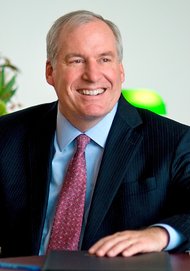Q. What were some early leadership lessons for you?
A. The earliest ones probably related to just understanding that everybody is wired a little bit differently. Just because you think a certain way or are inclined to react a certain way doesn’t mean everybody thinks and reacts the same way. I think people just naturally presume that they look at a problem in a certain way and frame the issue in a certain way and that everybody else would look at it the same way.
I learned in my 20s that there are a lot of different ways to look at things, a lot of different filters that people put on, partly based on how they analyze the circumstance but also based on their own history and perspectives and biases and instincts and so forth. You have to be open-minded about that and listen to what’s being said — but also to what’s not said sometimes. Those discussions can lead you to different places.
Q. Other big leadership lessons?
A. The core one is a Thomas Edison quote that summarizes my perspective on things, which is, “Vision without execution is hallucination.” I do believe in vision. I do believe in big ideas. I do believe in tackling problems that are complex and fighting battles that are worth fighting, and also trying to, in my case, create companies or back companies. That can change the world. The vision thing is really important — but the execution thing is really important, too. Having a good idea is not enough. You’ve got to figure out some way to balance that and complement that with great execution, which ultimately is people and priorities and things like that. You have to strike the right balance. If you have those together, I think anything is possible. If you don’t have both of them working together in a complementary, cohesive way, you’re not going to be successful.
Q. What about mentors?
A. One of the co-founders of AOL, Jim Kimsey, said something when I was about 26. My view, in the early part of my career, was that appearances mattered, that looking like you’re working hard mattered. I remember Jim saying once — and partly I think it relates to some of his training in the military — that really the art is trying to set the priorities and assemble a team so you wake up in the morning and actually have nothing to do. It’s impossible to achieve, but it’s a good goal to have the right priorities and the right team in place so they can execute against those priorities. It’s almost the opposite of how I was approaching it.
The objective should not be looking busy, but actually creating a process that allows great things to happen in a way that you can be less involved. So it was sort of a process of letting go, which is hard for entrepreneurs. But at some point you’ve got to let go and you’ve got to step back. Ultimately, that is about trusting the people you’ve got — but also trusting yourself, that you’ve set the right context in terms of the vision, the priorities, the team.
Q. With the benefit of time and hindsight, thoughts on the AOL-Time Warner merger?
A. They were both terrific companies. I think everybody saw it as a big idea to bring them together and help Time Warner move into the digital age and help AOL move into the broadband age. Well, it didn’t happen. The reason it didn’t happen is because the execution wasn’t up to the vision — going back to the Thomas Edison thing — and the primary reason was there were not the relationships and trust with people.
Ultimately, it came down to poor execution of what I thought was a good idea, and that was largely attributable to people and relationships and resentments and pride and egos. There were some substantive strategic debates, but it was mostly about people and trust and relationships. I’ve seen where it works well. It can really accelerate and animate a company to do things that nobody thought was possible. When it’s not working, you can’t get much done.
Q. On reflection, what should you have done differently?
A. It goes back to the people side. Both of the answers are probably somewhat impractical, but I think it would have resulted in a better company. One would be that if we’d brought these companies together — and I say this somewhat in jest, but it makes a point — we should have fired the top 50 executives, myself included, and hired 50 new executives who brought new perspectives and could look at this through the focus on the future, not in the rearview mirror. It would have done better. There is a reason why that happens whenever a new president is elected. They bring in an entirely new team to get behind their vision and execute that vision. If it were the same 50 people from the prior administration being asked to implement new policies for the new president, it would not work.
Article source: http://www.nytimes.com/2013/05/05/business/steve-case-on-risk-taking-or-lack-thereof-in-business.html?partner=rss&emc=rss
